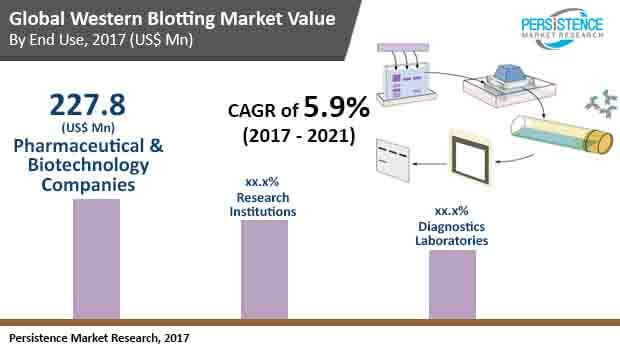Western Blotting Market Segmented By Electrophoresis Blotting Systems, Chromogenic Reagents Kits, Chemiluminescent Reagents Kits, Transfer Membranes Product in Diagnostic Laboratories, Research Institutions
Industry: Healthcare
Published Date: March-2018
Format: PPT*, PDF, EXCEL
Delivery Timelines: Contact Sales
Number of Pages: 174
Report ID: PMRREP3044
Western blotting or protein immunoblot is an analytical technique used to separate and detect specific proteins from a complex protein sample. Proteins are separated by gel electrophoresis based on molecular weight of proteins, which form bands on a gel and are then transferred onto a nitrocellulose or polyvinylidene fluoride membrane. The steps in western blotting are tissue preparation, gel electrophoresis, transfer of proteins onto membrane, blocking to prevent membrane and antibody interactions, incubation of membrane, and antibody-based detection of proteins.
Western blotting or immunoblotting technique has various advantages as compared with other immunosorbent assays (ISAs), for example ELISA. Western blotting technique is advanced than ELISA as it allows separation of the protein mix by charge, size and/or conformation.
This method of stripping used in western blotting can be used for the detection of a number of targets, while in ELISA only one protein can be detected. Due to the fact that gel electophoreis of proteins helps the separation of proteins into bands, the size of the target protein can be determined using this technique. In addition, the protein of interest can be semi-quantified by running an internal quantity standard simultaneously with the samples in the gel.
However, one of the main drawbacks of western blotting technique is that it is time-consuming as compared to ELISA and requires highly experienced lab technicians to perform this technique. Also, another drawback of western blotting is that it requires high optimization of experimental conditions like gel concentration, protein isolation, etc.

With the growing incidences of HIV in the world the market for western blotting is being boosted. Also, the rapidly expanding applications of western blotting in the field of proteomics and increased efforts and investments in research and development by several pharmaceuticals and biotechnology companies are other major drivers stimulating the growth of the global western blotting market, since this technique is being rapidly used in such areas. However, there are several restraints that are negatively affecting the market growth of western blotting.
One of them is the emergence of alpha technology that is a highly sensitive homogenous bead-based platform, and is used in the detection of biomolecules. Alpha technology holds several advantages over other technologies like western blotting since it doesn’t involve the cumbersome wash-steps and detects any molecule of interest, majorly from protein complexes.
Alpha technique works in a variety of serum, plasma, cell lysate and cell supernatant samples. Hence, alpha technology is an all-in-one-well protocol, unlike the several changes that are the norm in western blotting technique. Emergence of such kind of new technologies is likely to challenge the prominence of western blotting technique in the market.
Western blotting demands time and technical skill to detect specific protein in a complex mixture. Conventional western blots have inconsistent efficiency. Currently, increased throughput screening in western blotting is possible with automation, which enables numerous trials and accelerates experimentation. Automation of western blot enables analysis of multiple samples at once. Loading the sample is the only manual task with automated western blot systems.
| Attribute | Details |
|---|---|
| Product |
|
| End-Use |
|
| Application |
|
| Region |
|
To know more about delivery timeline for this report Contact Sales

These players have been profiled on the basis of various attributes such as company overview, recent developments, growth strategies, sustainability, and financial overview.